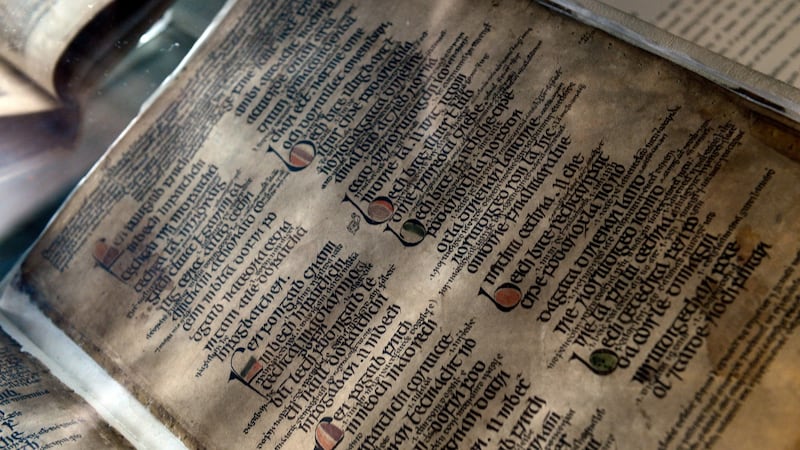From the control of dogs and bees to the roles of church and state, precious manuscripts outlining laws that governed everyday life in early medieval Ireland have gone on show at Trinity College Dublin as part of an important exhibition of rare Irish manuscripts.
The exhibition, drawn from the world’s largest and most important collection of medieval Irish manuscripts, is being held to mark two decades of the college’s collaboration on a digitisation project with the Dublin Institute for Advanced Studies on the Irish Script on Screen (ISOS).
Giving insights into the character of Irish life, society and social institutions in the early to late medieval era, the exhibition features manuscripts dating as far back as the 9th century.
Visitors to TCD’s Long Room and to an accompanying online exhibition can view manuscripts detailing early Irish sagas, genealogy and material about the lives of the saints. Other manuscripts inform our understanding of how Irish society was governed before the arrival of Canon law.
“What they give us the Irish view of self for the early medieval period,” says Professor of Early Irish in Trinity College, Damian McManus . They cover every aspect of Irish life and are “rather like newspapers today”.
“What we have is a tiny, tiny, fraction of the manuscripts that were available. So we treasure them even more because they are unique – they are the ones that managed to get through the net.
The honeybee
Perhaps one of the most compelling aspects of the exhibition is how it gives us an insight into the story of one young scholar. Notes written in the margins of a Brehon legal manuscript detailing the laws regulating the keeping of the honeybee introduce us to the life of Hugh McEgan.
The honeybee was of particular importance in Gaelic society as it was used to produce beeswax for candle making, waxed tablets, seals and adhesives.
At the bottom of one page, McEgan notes that he is writing on Christmas Eve, 1350, which was two years after the Black Death came to Ireland.

"He asks everybody who reads the page to say a prayer for his soul," says Prof McManus. "And, when we look at the Annals of Ulster nine years later, we find that he died. He was 21 when he wrote that note. He died at the age of 30 and his obituary says he had the makings of being a professor of juriprudence."
Leabhar Buidhe Leacáin (the Yellow Book of Lecan), a manuscript dating from the late 14th/early 15th century, has an outline of a seating plan for the tech midchúarta or banqueting hall of Tara and explains where cupbearers, stewards and the king's fools (drúith ríg) are located.
It also explains that the size of the tech midchúarta changed depending on the king in power but adds that it is not the same as it once was during the reign time of the legendary High King of Ireland Conn Cétchathach (Conn of the Hundred Battles).
Irish has the oldest vernacular literature in western Europe and some of the manuscripts featured in the exhibition capture the earliest written evidence of the language.
Dominant language
One manuscript that marks a cultural shift of its time is the ninth century Liber Ardmachanus (Book of Armagh). The book, which contains some of the earliest specimens of Old Irish in existence, was written at a time when Irish was encroaching on Latin, then the dominant language of scholarship.
“It is the first sign of an Irish consciousness of the value of the Irish language coming through because before then it was all Latin,” says Prof McManus. “It is really important to us because it contains texts in the Irish language about St Patrick. And they are the earliest continuous prose we have.”
He adds: “Ireland could easily have become a Romance language speaking country. Latin was a very prestigious language – just as English is today – and it could have taken over.
"But Irish scholars were determined that Irish would be the language of scholarship, and we see the beginning of that in the Book of Armagh. The texts in Irish are beginning to appear there and will eventually take over."
- The Irish Manuscripts in the Library of Trinity College exhibition at the Old Library will run from May 17 until the end of June. The online exhibition can be viewed at tcd.ie/library/exhibitions/irish-manuscripts/











